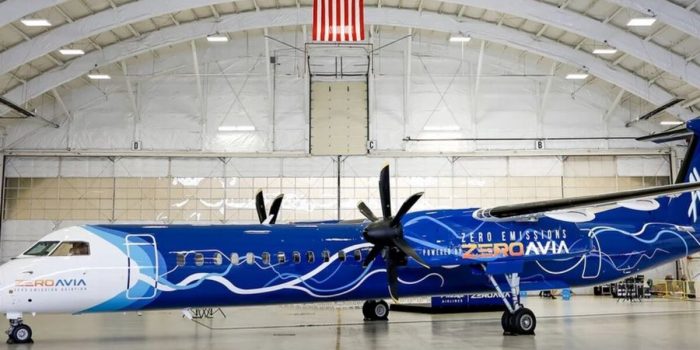Alaska Airlines and ZeroAvia have announced their partnership to explore zero-emission flights. ZeroAvia will retrofit one of Alaska’s Horizon Air fleet’s Bombardier Q400 turboprops with a hydrogen-electric propulsion system to investigate the capacity and technology of zero-emission flights.
The event was held at ZeroAvia’s Paine Field research and development site, where the Q400 aircraft was handed over to ZeroAvia by Alaska Airlines.

ZeroAvia has developed a multi-megawatt modular electric motor system, which was demonstrated with a propeller spin aboard its 15-ton HyperTruck ground-test rig. This technology, combined with higher-temperature PEM fuel cells and advanced power electronics, is expected to enable commercially-relevant hydrogen fuel cell engines for larger aircraft. The certifiable ZA2000 system will include ZeroAvia’s High-Temperature PEM fuel cells and liquid hydrogen fuel storage, integral to delivering the necessary energy density for commercial operations of large regional turboprops.
“Launching this program puts us on track for a test flight next year and accelerates our progress toward the future of zero-emission flight for Alaska Airlines and for the world at large,” said Val Miftakhov, founder and CEO of ZeroAvia.
“Demonstrating this size of aircraft in flight, powered entirely by novel propulsion, would have been unthinkable a few years ago,” Val added.
The collaboration aims to develop a commercially viable zero-emission airplane, and ZeroAvia plans to produce a powertrain for the Dash 8-400 that will be five times more potent than any other demonstrated so far. In addition, the goal is to have enough cell engine technology to operate routes for Alaska Airlines.

The partnership is a significant step forward in aviation innovation and demonstrates a commitment to creating a new future of flight.
“New technologies are required to make that future possible, and we’re thrilled to partner with industry leader ZeroAvia to make new zero-emissions options a reality,” Alaska Airlines CEO Ben Minicucci stated.
Congresswoman Suzan DelBene reiterated that decarbonizing commercial transportation is critical, and this partnership demonstrates how collaboration could revolutionize the aviation industry to make our skies cleaner.

ZeroAvia’s partnership with multiple regional carriers across the globe, including northern Sweden, plans to examine the potential for operating regional aircraft on commercial routes using ZeroAvia’s technologies.
The ZA600 powertrain, designed for 9-19 seat aircraft, has a proposed 2025 launch target, while the ZA2000 for 40-80 seat aircraft (in collaboration with ATR and Dash 8 aircraft) is expected to take off by 2027.

The collaboration between Alaska Airlines and ZeroAvia shows a commitment to innovation and a future of zero-emissions flights. ZeroAvia also aims to bring zero-emission flights to the highlands, partnering with AGS airports to explore hydrogen infrastructure in Aberdeen and Glasgow.


